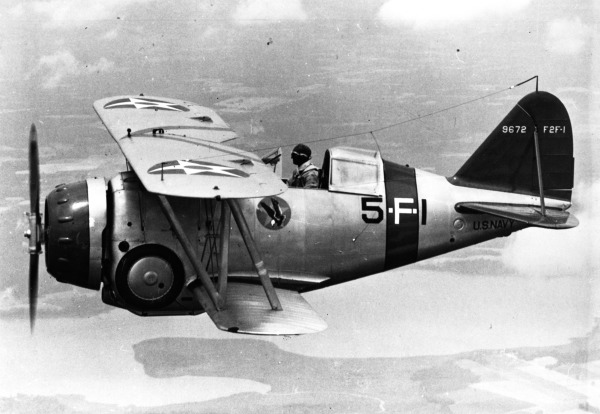
Design Development
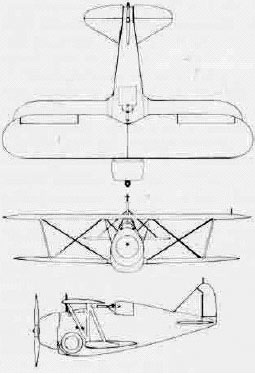 The outstanding performance of the Grumman FF-1 "Fifi" two-seat multirole aircraft, significantly faster than single-seat fighters of its day, prompted the Grumman design team to consider the potential of a single-seat version of the FF in 1932 already. In June Grumman submitted to the US Navy a carrier fighter proposal, the Grumman G-8. The navy accepted a prototype to be tested. The XF2F-1 prototype was completed in November the same year, slightly smaller than the FF, and with a semi-monocoque metal fuselage, reinforced metal wings, but the aileron and upper plane still canvas wrapped. It was a modern model with retractable landing gear, making the best of its engine.
The outstanding performance of the Grumman FF-1 "Fifi" two-seat multirole aircraft, significantly faster than single-seat fighters of its day, prompted the Grumman design team to consider the potential of a single-seat version of the FF in 1932 already. In June Grumman submitted to the US Navy a carrier fighter proposal, the Grumman G-8. The navy accepted a prototype to be tested. The XF2F-1 prototype was completed in November the same year, slightly smaller than the FF, and with a semi-monocoque metal fuselage, reinforced metal wings, but the aileron and upper plane still canvas wrapped. It was a modern model with retractable landing gear, making the best of its engine.
With its initial Power plant, the Pratt & Whitney XR-1534-44 Twin Wasp Junior (which developed 625 HP) but was still experimental, the prototype was also fitted with two standard 0.8-in (7.62 mm) M1919A4 Browning machine guns in the upper forward fuselage. The wings had mounts socket provision to mount two 50 kg bombs. But Grumman also brought to the design sealed watertight compartments in order to improve the chances of survival of the crew in case of splashdown due to the extra buoyancy.
The prototype made its maiden flight on October 18, 1933 in a configuration very close already to what the Navy might want. Jimmy Collins, Grumman's test pilot was at the controls, and reached 369 km/h () at 2,560 meters () of altitude at this occasion, which was 35 km/h faster than the FF-1 at the same altitude. He also proved maneuverability was superior (as expected) to the FF-1 as well, so far better suited as a fighter (Which was one of the FF roles already). After Grumman's own evaluations, the XF2F-1 (Note there was no F1F in Grumman's lineage, the place was taken by the FF-1, a different code for a different role) was placed in the hands of the Navy for official tests, over a six-month program of evaluation.
Navy test pilot pushed it to a maximum speed of 370 km/h at 2,500 m alt. () and established a climbing speed of 940 m per minute (ft second) but it should be noted that the stubby, stocky fuselage suffered from directional instability, pilots also noted its tendency to spin in an unsafe way. Thus the Navy praised the performances but asked Grumman minor to improved the noted issues. Grumman added a larger canopy for better visibility, made a 15 cm () increase in wingspan for the upper plane only, replaced the NACA hood with one of a smaller diameter, with distinctive droplet shaped fairings for the cylinder heads. The modified XF2F-1 flew again in May 1934, and was eccapted by the Navy for service on its carriers. Thus, were ordered 54 production F2F-1 fighters on May 17, 1934.
PRODUCTION
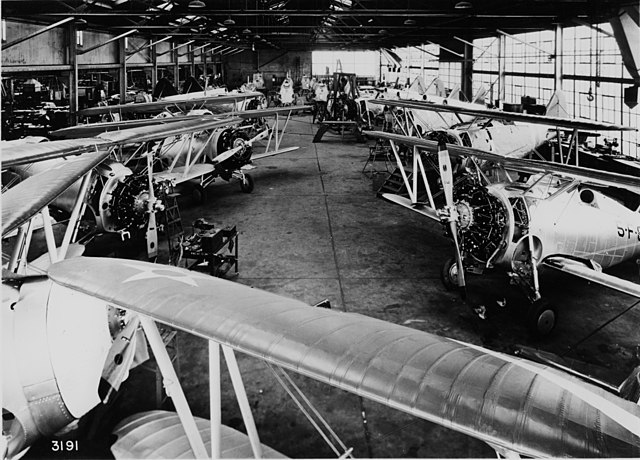 The first production F2F-1 was delivered on January 28, 1935, the last 10 months later. This was a short production run, because Grumman in between already had worked on its successor, the F3F. An additional prototype was ordered to replace the one that crashed on March 16, 1935, for a total number of 55 F2F-1s delivered in all. But this was only serie. Instead of an improved F2F-2 as asked by the Navy, Grumman went with another proposal, radically improved, which became the very last USN biplane fighter in 1936, the F3F, and direct predecessor of the monoplane F4F Wildcat.
The first production F2F-1 was delivered on January 28, 1935, the last 10 months later. This was a short production run, because Grumman in between already had worked on its successor, the F3F. An additional prototype was ordered to replace the one that crashed on March 16, 1935, for a total number of 55 F2F-1s delivered in all. But this was only serie. Instead of an improved F2F-2 as asked by the Navy, Grumman went with another proposal, radically improved, which became the very last USN biplane fighter in 1936, the F3F, and direct predecessor of the monoplane F4F Wildcat.
VARIANTS & EVOLUTION
XF2F-1: USN designation for the Grumman Model G-8 prototype (625 hp -466 kW- XR-1534-44 Twin Wasp Junior radial engine), only one delivered.F2F-1: Sole production variant, 700 hp (522 kW) R-1535-72 Twin Wasp Junior radial engine: 55 built.
The F2F-1 differed from the prototype by its upper wing 6in longer in span, enlarged cockpit canopy, smoother, smaller NACA cowling with streamlined blisters over the cylinders. The Pratt & Whitney R-1535-72 Twin Wasp Junior was rated at 650hp and up to 700hp depending on the regime. Top speed of 231mph stayd very close to the prototype.
No F2F-2, but the Navy wanted on 15 October 1934 an improved prototype called XF3F-1. The F3F was clearly related to the F2F, and order was placed even before F2F deliveries started. The Navy added a reinforced cell to perform ground attack while maintaining fighter performances and better maintenance and supply access, cheaper overall, but it was to be powered by the very same Pratt & Whitney R-1535-72 Twin Wasp Junior engine.
Engineers found solutions with a lenghtened and strenghtened fuselage, increased wing area, reduced wheel diameter to increase fuselage streamlining, but all the rest was stright from the Grumman F2F.
The first F3F, BuNo. 9727 was delivered on 20 March 1935 to factory's test pilot Jimmy Collins, noted corrections to make, two days later during testing bombing capabilities at the 10th dive when recovering, sensors registed 14 g and wings broke in mid-air. This resulted in a rapid crash, causing the death of Jimmy Collins, a hard blow for Leroy Grumman and all his staff, needless to say for the family. All because the Navy wanted a fighter that can double as dive bomber... to later relinquish this specification.
The F2F service
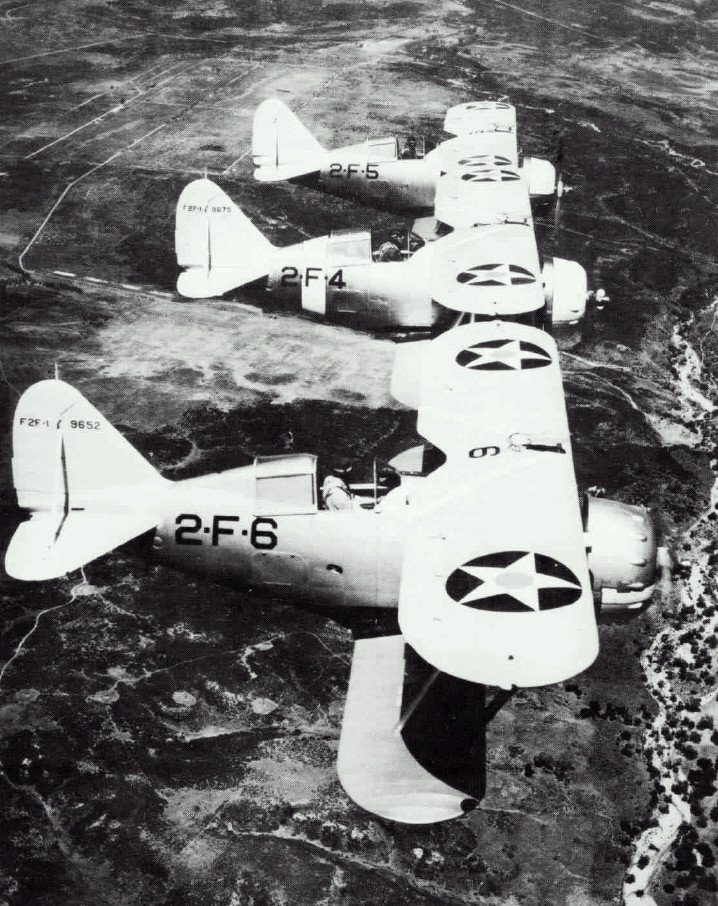 The serial F2F were first delivered on 19 January 1935. They served with front-line squadrons from 1935 to late 1939. F2F-1s began to replace the Boeing F4B-2s of VF-2B, stationed on the aircraft carrier USS Lexington, on February 19, 1935.
The first squadron converting was indeed VF-2B (‘Fighting Two’, USS Lexington) as they arrived to start later pilot qualifications from 19 February 1935, and she had fully converted her fighter squadron by the middle of the year. These were ultimately retired on 30 September 1940, the surviving 18 aircraft sent to NAS Pensacola to end as advanced trainers.
The serial F2F were first delivered on 19 January 1935. They served with front-line squadrons from 1935 to late 1939. F2F-1s began to replace the Boeing F4B-2s of VF-2B, stationed on the aircraft carrier USS Lexington, on February 19, 1935.
The first squadron converting was indeed VF-2B (‘Fighting Two’, USS Lexington) as they arrived to start later pilot qualifications from 19 February 1935, and she had fully converted her fighter squadron by the middle of the year. These were ultimately retired on 30 September 1940, the surviving 18 aircraft sent to NAS Pensacola to end as advanced trainers.
The second squadron was VF-3B (USS Ranger) also converted by mid-1935. The squadron moved ship twice, swapping to USS Yorktown in 1937 as VF-7B and then VF-5 to reflect Yorktown's new pennant CV-5. The squadron converted to the Grumman F3F in 1939.
The F2F-1 briefly was used used in VF-5B as an interim before receiving the F3F-1 in 1936. VF-7 used 2 F2F-1s and VF-4M (later VMF-2) 3 F2F-1s also in 1937, again before F3F-1 arrived. The F2Fs became a perfect advance trainer in its second carrer from 1937-38, as gunnery platform notably, and pilot appreciated to swap from the very similar F2F and F3F. The F2F was attached to various Naval Air Stations and patrol wings but ended in 1940-41 with NAS Miami and NAS Pensacola, the last F2F-1 retired in 1942, although some sources stated it was used until 1943.
The F2F-1 had a relatively good service career for its time, serving in limited front-line squadrons from 1935 to 1939 on carriers, and to September 1940 in land units only as F3F-3s were received as replacements. It completely replaced in all fighter squadrons, but continued to be used as a fire trainer and utility aircraft at various naval air bases until declared "surplus to requirement" in 1942 the remaining planes were scrapped. The technological gap was just to great between the F2F and Wilcat, let alone the Hellcat that was just entering service. It seems unfortunately none survived to this day, they were all scrapped untlike the F3F.
⚙ PLANE specifications | |
| Empty Weight | 2,691 lb (1,221 kg) |
| Max Takeoff weight | 3,847 lb (1,745 kg) |
| Lenght | 21 ft 5 in (6.53 m) |
| Wingspan | 28 ft 6 in (8.69 m) |
| Height | 9 ft 1 in (2.77 m) |
| Wing Area | 230 sq ft (21.4 m2) |
| Engine | Pratt & Whitney R-1535-72 Twin Wasp Junior radial engine, 700 hp (522 kW) |
| Top Speed, sea level | 231 mph (372 km/h, 201 kn) |
| Range | 985 mi (1,585 km, 857 nmi) |
| Climb Rate | 2,050 ft/min (10.4 m/s) |
| Ceiling | 27,100 ft (8,260 m) |
| Armament | 2× .30-in machine guns |
| Crew | 1 Pilot |
Read More
Books
Cacutt, Len, ed. “Grumman Single-Seat Biplane Fighters.” Great Aircraft of the World. London: Marshall Cavendish, 1989.Dann, Richard LCDR, ed. “Grumman Biplane Fighters in Action.” Carrollton, TX: Squadron Signal, 1993.
Graff, Cory. F6F Hellcat at War. New York: Zenith Imprint, 2009.
Swanborough, Gordon and Peter M. Bowers. United States Navy Aircraft since 1911. London: Putnam, Second edition, 1976.
Naval Fighters - Grumman F2F and F3F (pre-war Navy/Marine biplane fighters & Civilian Variants By Richard S. Dann
Links
cradleofaviation.org grummans_ascendancy on militaryfactory.com/ commons.wikimedia.org/ cc photos on en.wikipedia.org on airvectors.net on historyofwar.org/ on aviastar.org on armedconflicts.com/Model Kits
General Query on Scalemates Plenty of choice, but far less than the F3F or F4F understandably. Especially old kits, starting at 1:17, then 1:24, 1:48, and plethora of 1:72. Trumpeter made squadrons of them at 1:350 and 1:700 to pupolate CVs. Among the recent ones, F2F-1 from Attack Squadron (kit # 72068), 1:72 scale. Review of the latter.3D
Kampflieger 1/144 3d print modelVideo
Rex Hangar's F2F and F3F.
Gallery:

F2F-1 from VF-5, 1937, USS Yorktown.
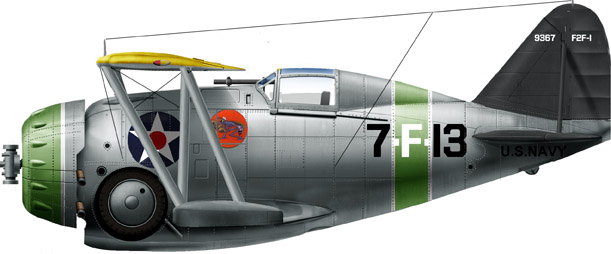
F2F-1 VF-7, 1940 Neutrality Patrol, aboard CV-7 USS Wasp.

F3F-1 aboard USS Lexington, 1937, to compare.
Onboard USS Yorktown 1939
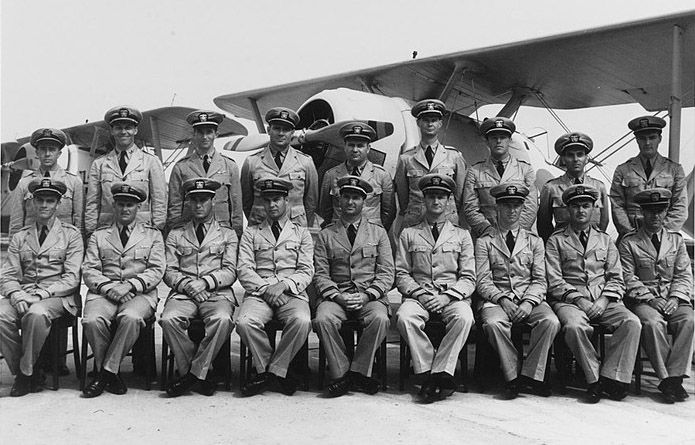
F2F-1 of FV-5

Ray Wagner Coll. F2F-1

Ray Wagner Coll. F2F-1

F2F-1 from VF-3B, Burbank circa 1936, Ludlow
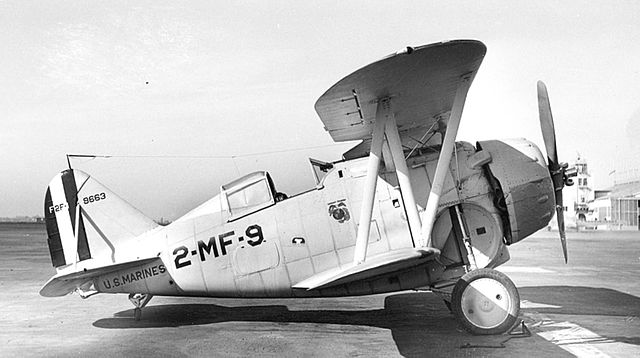
F1F-1

F2F-1, 2F6 NAN
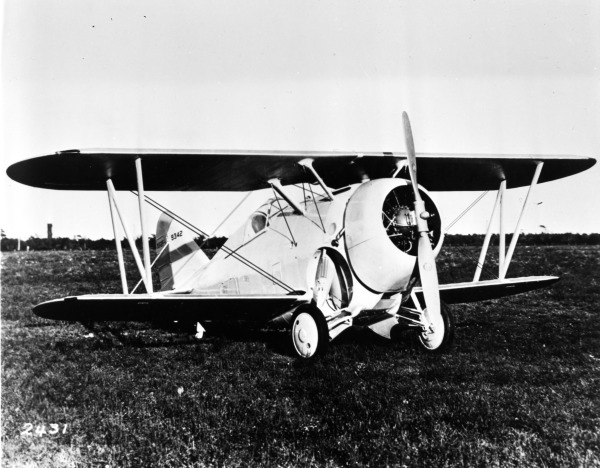
F2F-1, Ray Wagner Coll.

F2F-1 from VF-5, 1937, USS Yorktown.

F2F-1 VF-7, 1940 Neutrality Patrol, aboard CV-7 USS Wasp.

F3F-1 aboard USS Lexington, 1937, to compare.
Photos

Onboard USS Yorktown 1939

F2F-1 of FV-5

Ray Wagner Coll. F2F-1

Ray Wagner Coll. F2F-1

F2F-1 from VF-3B, Burbank circa 1936, Ludlow

F1F-1

F2F-1, 2F6 NAN

F2F-1, Ray Wagner Coll.
- Lohner E (1913)
- Macchi M3 (1916)
- Macchi M5 (1918)
- Ansaldo ISVA (1918)
- Sopwith Baby (1916)
- Short 184 (1916)
- Fairey Campania (1917)
- Sopwith Cuckoo (1917)
- Felixstowe F.2 (1917)
- Friedrichshafen FF 33 (1916)
- Albatros W4 (1916)
- Albatros W8 (1918)
- Hanriot HD.2
- Grigorovitch M5
- IJN Farman MF.7
- IJN Yokosho Type Mo
- Yokosho Rogou Kougata (1917)
- Yokosuka Igo-Ko (1920)
- Curtiss N9 (1916)
- Aeromarine 39
- Vought VE-7
- Douglas DT (1921)
- Boeing FB.5 (1923)
- Boeing F4B (1928)
- Vought O2U/O3U Corsair (1928)
- Blackburn Blackburn (1922)
- Supermarine Seagull (1922)
- Blackburn Ripon (1926)
- Fairey IIIF (1927)
- Fairey Seal (1930)
- LGL-32 C.1 (1927)
- Caspar U1 (1921)
- Dornier Do J Wal (1922)
- Rohrbach R-III (1924)
- Mitsubishi 1MF (1923)
- Mitsubishi B1M (1923)
- Yokosuka E1Y (1923)
- Nakajima A1N (1927)
- Nakajima E2N (1927)
- Mitsubishi B2M (1927)
- Nakajima A4N (1929)
- CANT 18
WW1
✠ K.u.K. Seefliegerkorps:
 Italian Naval Aviation
Italian Naval Aviation
 RNAS
RNAS
 Marineflieger
Marineflieger
 French Naval Aviation
French Naval Aviation
 Russian Naval Aviation
Russian Naval Aviation
 IJN Air Service
IJN Air Service
 USA
USA
Interwar
 Interwar US
Interwar US
 Interwar Britain
Interwar Britain
 Interwar France
Interwar France
 Interwar Germany
Interwar Germany
 Interwar Japan
Interwar Japan
 Interwar Italy
Interwar Italy
- Curtiss SOC seagull (1934)
- Grumman FF (1931)
- Curtiss F11C Goshawk (1932)
- Grumman F2F (1933)
- Grumman F3F (1935)
- Northrop BT-1 (1935)
- Grumman J2F Duck (1936)
- Consolidated PBY Catalina (1935)
- Brewster/NAF SBN-1 (1936)
- Curtiss SBC Helldiver (1936)
- Vought SB2U Vindicator (1936)
- Brewster F2A Buffalo (1937)
- Douglas TBD Devastator (1937)
- Vought Kingfisher (1938)
- Curtiss SO3C Seamew (1939)
- Douglas SBD Dauntless (1939)
- Grumman F4F Wildcat (1940)
- F4U Corsair (NE) (1940)
- Brewster SB2A Buccaneer (1941)
- Grumman TBF/TBM Avenger (1941)
- Consolidated TBY Sea Wolf (1941)
- Grumman F6F Hellcat (1942)
- Curtiss SB2C Helldiver (1942)
- Curtiss SC Seahawk (1944)
- Grumman F8F Bearcat (1944)
- Ryan FR-1 Fireball (1944)
- Douglas AD-1 Skyraider (1945)
Fleet Air Arm
- Fairey Swordfish (1934)
- Blackburn Shark (1934)
- Supermarine Walrus (1936)
- Fairey Seafox (1936)
- Blackburn Skua (1937)
- Short Sunderland (1937)
- Blackburn Roc (1938)
- Fairey Albacore (1940)
- Fairey Fulmar (1940)
- Grumman Martlet (1941)
- Hawker sea Hurricane (1941)
- Brewster Bermuda (1942)
- Fairey Barracuda (1943)
- Fairey Firefly (1943)
- Grumman Tarpon (1943)
- Grumman Gannet (1943)
- Supermarine seafire (1943)
- Blackburn Firebrand (1944)
- Hawker Sea Fury (1944)
IJN aviation
- Aichi D1A "Susie" (1934)
- Mitsubishi A5M "Claude" (1935)
- Nakajima A4N (1935)
- Yokosuka B4Y "Jean" (1935)
- Mitsubishi G3M "Nell" (1935)
- Nakajima E8N "Dave" (1935)
- Kawanishi E7K "Alf" (1935)
- Nakajima B5N "Kate" (1937)
- Kawanishi H6K "Mavis" (1938)
- Aichi D3A "Val" (1940)
- Mitsubishi A6M "zeke" (1940)
- Nakajima E14Y "Glen" (1941)
- Nakajima B6N "Jill" (1941)
- Mitsubishi F1M "pete" (1941)
- Aichi E13A Reisu "Jake" (1941)
- Kawanishi E15K Shiun "Norm" (1941)
- Nakajima C6N Saiun "Myrt" (1942)
- Yokosuka D4Y "Judy" (1942)
- Kyushu Q1W Tokai "Lorna" (1944)
Luftwaffe
- Arado 196 (1937)
- Me109 T (1938)
- Blohm & Voss 138 Seedrache (1940)
Italian Aviation
- Savoia-Marchetti S.55
- IMAM Ro.43/44
- CANT Z.501 Gabbiano
- CANT Z.506 Airone
- CANT Z.508
- CANT Z.511
French Aeronavale
- GL.300 (1926-39)
- Levasseur PL.5 (1927)
- Potez 452 (1935)
- Loire 210 (1936)
- Loire 130 (1937)
- LN 401 (1938)
Soviet Naval Aviation
- Shavrov SH-2 (1928)
- Tupolev TB-1P (1931)
- Beriev MBR-2 (1930)
- Tupolev MR-6 (1933)
- Tupolev MTB-1 (1934)
- Beriev Be-2 (1936)
- Polikarpov I16 naval (1936)
- Tupolev MTB-2 (1937)
- Ilyushine DB-3T/TP (1937)
- Beriev Be-4 (1940)
-
Skoda Š-328V
R-XIII Idro
Fokker C.XI W (1934)
WW2
- De Havilland Sea Vixen
- Hawker Sea Hawk
- Supermarine Scimitar
- Blackburn Buccaneer
- Hawker Sea Harrier
- Douglas A4 Skyhawk
- Grumman F9F Panther
- Vought F8 Crusader
- McDonnell-Douglas F-4 Phantom-II
- North Am. A5 Vigilante
- TU-142
- Yak 38 forger
☢ Cold War
✧ NATO
 Fleet Air Arm
Fleet Air Arm
 US Navy
US Navy
☭ Warsaw Pact
Merch

Seafire Mark 45; HMS Pretoria Castle

Zeros vs its aversaries

Aichi D3A “Val” Junyo

Mitsubishi A5M poster

F4F wildcat

Macchi M5

SBD Dauntless Coral Sea

SBD Dauntless USS Enterprise

SBD-4 CV22